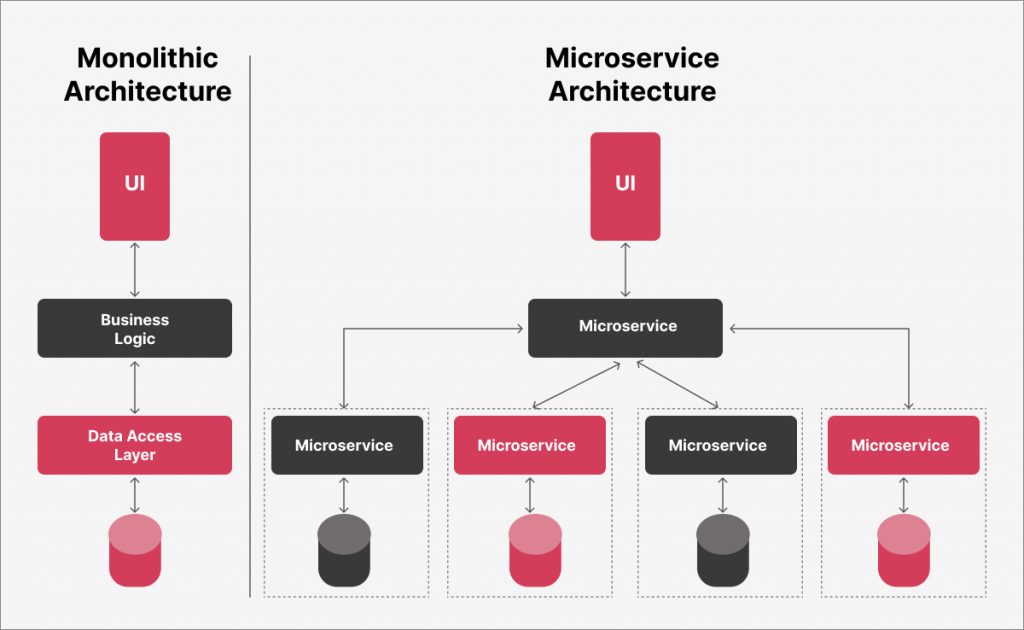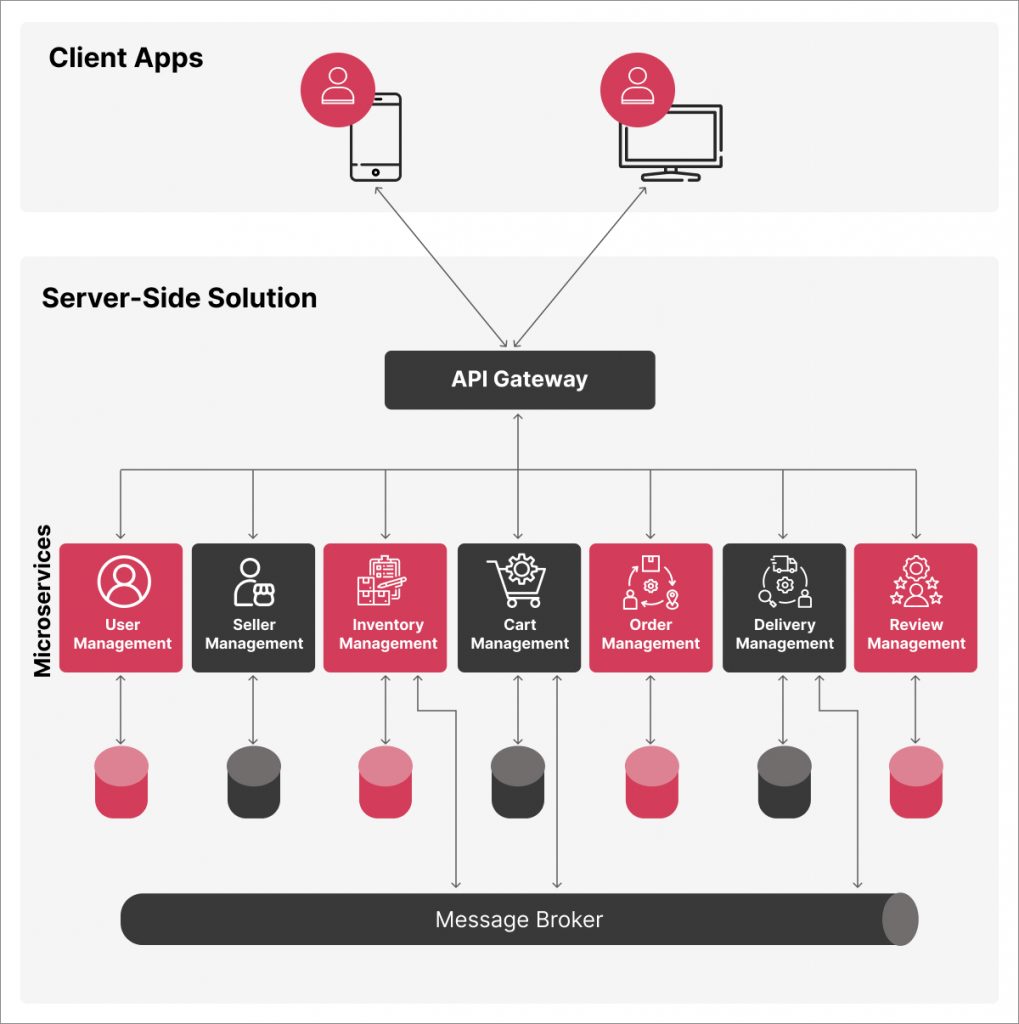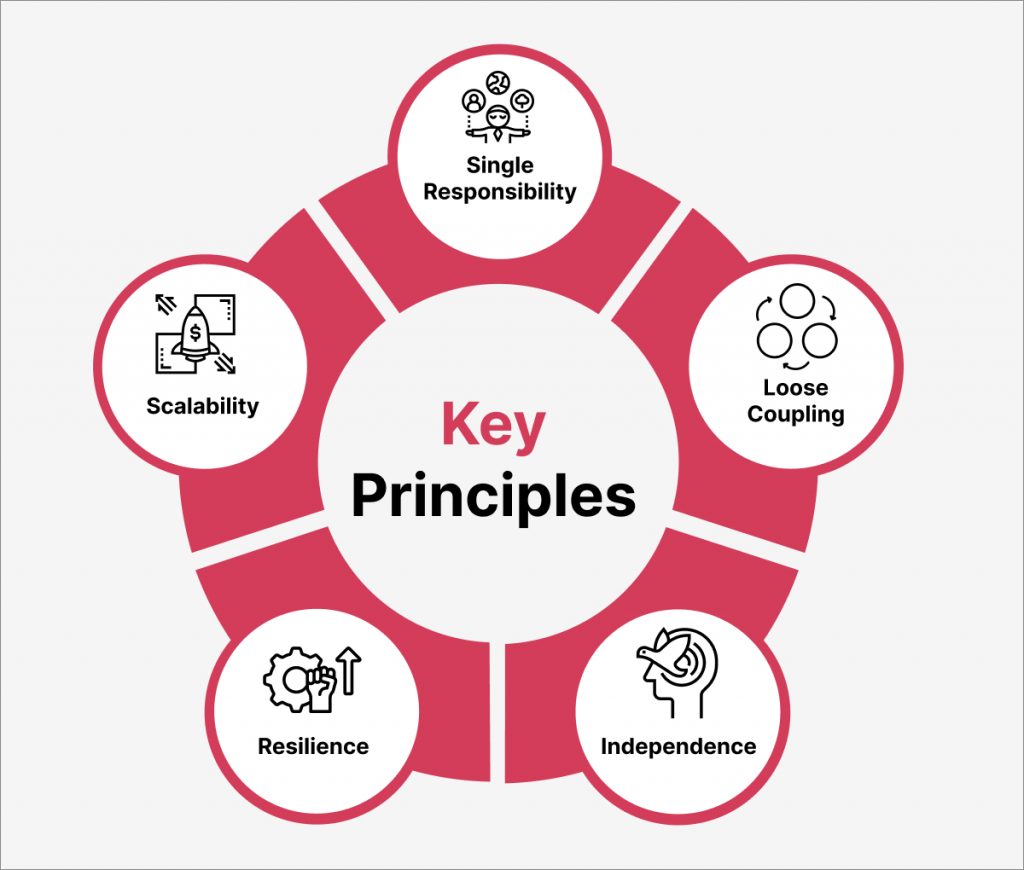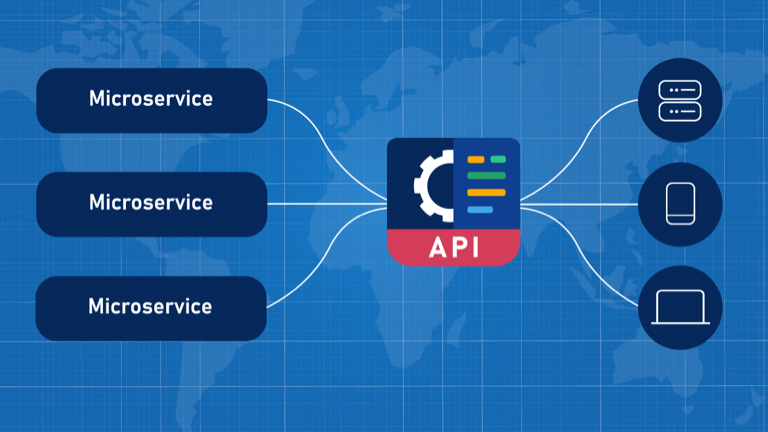Microservices architecture is reshaping modern software development, offering a scalable and flexible alternative to traditional monolithic systems. As application demands grow and evolve, many organizations are turning to this approach to achieve greater agility and ease of maintenance.
In this article, we’ll explore how microservices architecture compares to monolithic systems, its core principles, and why organizations are increasingly making the shift.
Why do organizations prefer microservices over monolithic architecture?
Monolithic and microservices architecture are two distinct approaches to building software systems.

As the name suggests, monolithic refers to mono – one, lithic means rock, one big piece of rock. In monolithic, the server-side solution can be built as one big chunk, whereas microservices are a group of small autonomous services that communicate with one another through APIs.
To understand these two architectures, let us consider a business requirement – an eCommerce solution where users can:
- View different items on the eCommerce site
- Add items to the cart
- Go through checkout and deliver flow
With monolithic architecture, entire business logic can be implemented as one service with business logic in a single database. But with the microservices architecture, we can identify many autonomous services, and each service can cater to particular business requirements.
Example: we can identify the following microservices: user management, inventory management, cart management, order management, review management, delivery management, offer management, etc. Each service will have its own specific database.

Key principles of microservices architecture
Let us look at the core microservices architecture principles underpinning the design and implementation of microservices-based systems.

- Single responsibility: each microservice focuses on a specific business capability and is responsible for performing a single task or function.
- Loose coupling: microservices communicate with each other through well-defined interfaces, such as APIs, enabling them to evolve independently without impacting the entire system.
- Independence: microservices are developed, deployed, and managed independently, allowing teams to work on different services simultaneously using diverse technologies and programming languages.
- Resilience: the failure of one microservice should not cause a cascading failure in the entire application. Services are designed to be fault-tolerant and can gracefully handle errors and recover without affecting the overall system.
- Scalability: each microservice can be scaled independently based on its specific demands, ensuring efficient resource utilization and high performance.
Benefits of microservices architecture
Now, let us look at the myriad benefits of microservices architecture:
- Agility and faster time-to-market: independent development and deployment of the architecture enable faster iterations, making it easier for developers to introduce new features and updates to the Micro apps.
- Scalability: microservice-based architecture enables horizontal scaling by allowing individual services to be replicated and deployed independently, ensuring efficient resource allocation and responsiveness.
- Technology diversity: the microservices architecture can be developed using different technologies, enabling teams to choose the best-suited tools and frameworks for each service. Services can be developed using Java, Spring Boot, Python, Node.js, etc.
- Fault isolation and resilience: failure in one microservice does not impact the entire system, as other services can continue to function, ensuring higher system resilience.
- Team autonomy: microservices enable decentralized development teams to work on different services independently, promoting faster decision-making and enhancing organizational agility.
Why migrate from a monolithic to a microservices-based architecture?
Monolithic architecture has various challenges that can be mitigated by migrating to a microservice-based architecture. Some of the key issues with monolithic architecture include:
- Large codebase: there could be thousands of files and commits and many teams contributing to the same codebase. The large code base makes it difficult for developers to understand the code and make changes for any enhancements and defect fixing. Thus, maintenance becomes difficult.
- Tight coupling limitations: tight coupling between components as everything is in one application. Changing one thing will require changing other components, which is against the open-close principle.
- Less scalable: only horizontal scaling of the entire application is possible, i.e. Setting up multiple instances of your application behind a load balancer can allow you to scale horizontally. This would unnecessarily incur costs. However, scaling a particular service is not possible.
- Inefficient deployment: the entire application needs to be deployed, even for small defect fixes.
- Defined tech stack: the entire application uses a particular tech stack; we cannot use another tech stack later. But with microservice-based architecture, the services can use different tech stacks.
- Limited service monitoring: in monolithic architecture, it is not possible to determine the Key Performance Indicator of certain services as it only allows monitoring of independent services.
- Single point of failure: if something goes wrong, this could bring down the application, and the entire application needs to be restarted.
Challenges with microservices architecture
- Service communication: effective communication between microservices is vital. One of the main challenges is ensuring seamless interactions among different services. Implementing well-defined APIs, event-driven architecture, or message queues can help manage service interactions efficiently. When choosing how services will communicate with each other, the outright candidate tends to be HTTP – REST (Representational State Transfer) or RPC (Remote Procedure Calls). Another method is Event-driven or Message-driven, which is asynchronous communication where a service does not wait for a response after sending the request and removes the coupling between services. Unlike HTTP communication, the services involved do not directly communicate with each other. Instead, the services push messages to a message broker that is subscribed to by other services.
- Data management: maintaining data consistency across multiple services can be challenging. Techniques like event sourcing, CQRS (Command Query Responsibility Segregation), and distributed transactions can be employed to handle data integrity.
- Deployment and infrastructure: the microservices architecture requires robust deployment strategies and scalable infrastructure to handle service discovery, load balancing, and fault tolerance. A microservice ecosystem cannot do without experienced DevOps engineers.
- Monitoring and observability: comprehensive monitoring and logging are essential to gain insights into service health, performance, and dependencies.
Tools used for building and managing microservices
There are several popular tools and frameworks available for building and managing Microservices. Here are some of the commonly used ones:
- Docker: is a popular containerization platform that allows you to package your Microservices and their dependencies into lightweight, portable containers. It simplifies the deployment and scaling of microservices by providing a consistent runtime environment.
- Kubernetes: is an open-source container orchestration platform that automates the deployment, scaling, and management of containerized applications, including microservices. It helps with load balancing, service discovery, and self-healing capabilities.
- Argo CD: is an open-source, declarative, GitOps continuous delivery tool for Kubernetes applications. It provides a Web user interface and command-line interface (CLI) for deploying applications to Kubernetes clusters and can determine deployment issues. Moreover, it helps in detecting and remediating configuration drift.
- Apache Kafka: is a distributed streaming platform often used as a messaging system in Microservices-based architecture. It provides reliable, scalable, fault-tolerant event streaming and allows different microservices to communicate asynchronously through message queues.
- Consul: is a service mesh and service discovery tool that helps manage the network communication between microservices. It provides service registration, health checking, distributed key-value storage, and features like traffic management and service segmentation.
- Istio: is another popular service mesh that provides a unified control plane for managing and securing Microservices. It offers traffic management, load balancing, fault injection, and observability features, helping to decouple application code from network concerns.
- Envoy: is a high-performance proxy server often used as a sidecar proxy in microservices-based architecture. It provides advanced load balancing, routing, and observability capabilities, making it easier for developers to implement resilience, security, and monitoring features.
- Prometheus: is an open-source monitoring and alerting toolkit widely used in microservices environments. It collects metrics, tracks service health, and provides a powerful query language for analyzing and visualizing performance data.
- Grafana: is an open-source observability tool used to build dashboards that visualize data provided by Prometheus (traces, metrics, and logs) and other data sources.
- Kibana: is used for logging and log analytics, infrastructure metrics and container monitoring, and application performance monitoring.
- Zipkin: is a distributed tracing system that helps understand the behavior of microservice-based architecture and troubleshoot any issues. It provides insights into the flow of requests across different services and helps identify performance bottlenecks and dependencies.
- PagerDuty: ensures complete reliability with on-call management and automated incident response. It keeps teams connected to the code in production, leverages machine learning to filter out noise, and alerts them when their attention is required during critical moments.
These are just a few examples of the tools available in the microservices ecosystem. The choice of tools may vary depending on the microservices architecture’s specific requirements and technology stack.
When is the time to move from monolithic to microservices architecture?
Simple applications can still use the monolithic architecture to avoid the overhead of managing many services and databases. Migrating an app to microservices is most appropriate when the application grows in size or complexity and encounters performance bottlenecks in critical functionalities. When encountering such issues with monolithic architecture, it is time to migrate to microservice-based architecture to take your application or business to the next level.
Ultimately, the choice between monolithic and microservices should be based on carefully considering the specific requirements and trade-offs of the project at hand.






